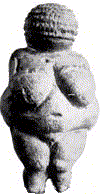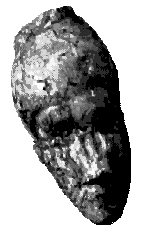Interpretations of Pre-historic Art

| A Middlesex University resource by Andrew Roberts |
Interpretations of Pre-historic Art |

|
|
This page is developed from notes written by Marcie Martin: 28.2.2000
In the first session of our course we were shown slides of symbols. In small groups we had to discuss and take notes on what we felt the symbols might represent. The main notes below from a group that Margaret Ndagire, Marcie Martin, Redempta Friday, Anita Howard and others formed. Slide One had symbols (figures) that appeared to be representations of a female form.
We thought the figures represented a woman of some kind a because of her voluptuous figure which was full and well rounded. Due to the shape and size of the figure, we identified it as being a fertility symbol and some of us felt that from the side profile it could be a nursing mother that is also linked to fertility.
The second group on slide one (not shown here) is also a woman. The lower
half of the figure is of a rounded shape; while from the waist up the
figure is a far more slender shape. This figure we felt might have
representation of women of a later time when women were not as curvaceous
as the top figure.
Some one else thought the bottom pair might be a king
sitting on a throne. Everyone seemed to think the first group were female.
Not everyone agreed about the gender of the second group.
Slide Three had two figures, one female and one male. The female a young graceful strong and shapely women. The male symbol is of a strong, masculine figure that appears to be missing the lower half of his leg. We felt that he may be one of three things a warrior, fighter or a slave.
 Study
Link Study
Link
 Andrew Roberts' web Study Guide Andrew Roberts' web Study Guide
 Top of
Page Top of
Page
 Take a Break - Read a Poem
Take a Break - Read a Poem
 Click coloured words to go where you want Click coloured words to go where you want
Andrew Roberts likes to hear from users:
|
click on a picture to go to discussion 

|